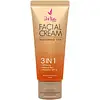What's inside
What's inside
 Key Ingredients
Key Ingredients

 Benefits
Benefits

 Concerns
Concerns

 Ingredients Side-by-side
Ingredients Side-by-side

Water
Skin ConditioningDipropylene Glycol
HumectantGlycerin
HumectantButylene Glycol
HumectantPEG-240/Hdi Copolymer Bis-Decyltetradeceth-20 Ether
StabilisingMica
Cosmetic ColorantPhenoxyethanol
PreservativeMethylparaben
PreservativeAcrylates/C10-30 Alkyl Acrylate Crosspolymer
Emulsion StabilisingNiacinamide
SmoothingChlorphenesin
AntimicrobialSilica
AbrasiveEthylhexylglycerin
Skin ConditioningSodium Hydroxide
BufferingAlcohol
Antimicrobial3-O-Ethyl Ascorbic Acid
Skin ConditioningDisodium EDTA
Parfum
MaskingSodium Ascorbyl Phosphate
AntioxidantSodium Hyaluronate
HumectantAcmella Oleracea Extract
Skin ProtectingGardenia Florida Fruit Extract
Skin ConditioningPotassium Laurate
EmulsifyingCaprylic/Capric Triglyceride
MaskingHaematococcus Pluvialis Extract
AntioxidantBHT
AntioxidantTocopherol
AntioxidantLimonene
PerfumingCI 77491
Cosmetic ColorantCI 77891
Cosmetic ColorantWater, Dipropylene Glycol, Glycerin, Butylene Glycol, PEG-240/Hdi Copolymer Bis-Decyltetradeceth-20 Ether, Mica, Phenoxyethanol, Methylparaben, Acrylates/C10-30 Alkyl Acrylate Crosspolymer, Niacinamide, Chlorphenesin, Silica, Ethylhexylglycerin, Sodium Hydroxide, Alcohol, 3-O-Ethyl Ascorbic Acid, Disodium EDTA, Parfum, Sodium Ascorbyl Phosphate, Sodium Hyaluronate, Acmella Oleracea Extract, Gardenia Florida Fruit Extract, Potassium Laurate, Caprylic/Capric Triglyceride, Haematococcus Pluvialis Extract, BHT, Tocopherol, Limonene, CI 77491, CI 77891
Morus Alba Extract
AstringentPanax Ginseng Root Extract
EmollientTitanium Dioxide
Cosmetic ColorantWater
Skin ConditioningGlycerin
HumectantTocopheryl Acetate
AntioxidantRetinyl Acetate
Skin ConditioningEthylhexyl Methoxycinnamate
UV AbsorberDimethicone
EmollientSodium Hyaluronate
HumectantAloe Barbadensis Leaf Extract
EmollientAscorbic Acid
AntioxidantMethylparaben
PreservativeParfum
MaskingDisodium EDTA
Ingredients Explained
These ingredients are found in both products.
Ingredients higher up in an ingredient list are typically present in a larger amount.
Disodium EDTA plays a role in making products more stable by aiding other preservatives.
It is a chelating agent, meaning it neutralizes metal ions that may be found in a product.
Disodium EDTA is a salt of edetic acid and is found to be safe in cosmetic ingredients.
Learn more about Disodium EDTAGlycerin is already naturally found in your skin. It helps moisturize and protect your skin.
A study from 2016 found glycerin to be more effective as a humectant than AHAs and hyaluronic acid.
As a humectant, it helps the skin stay hydrated by pulling moisture to your skin. The low molecular weight of glycerin allows it to pull moisture into the deeper layers of your skin.
Hydrated skin improves your skin barrier; Your skin barrier helps protect against irritants and bacteria.
Glycerin has also been found to have antimicrobial and antiviral properties. Due to these properties, glycerin is often used in wound and burn treatments.
In cosmetics, glycerin is usually derived from plants such as soybean or palm. However, it can also be sourced from animals, such as tallow or animal fat.
This ingredient is organic, colorless, odorless, and non-toxic.
Glycerin is the name for this ingredient in American English. British English uses Glycerol/Glycerine.
Learn more about GlycerinMethylparaben is a preservative and is a paraben. It is used to prevent the growth of fungus, mold, and other harmful bacteria. Parabens are chemicals used as preservatives in both cosmetics and food.
Methylparaben can be synthetically created. It can also be found naturally in some fruits, such as blueberries.
Oftentimes, Methylparaben is combined with other parabens to help increase the shelf life.
The safety of Methylparaben is currently being studied. While ongoing studies are looking into the safety of parabens, the results have been very mixed. Some studies have not found Methylparaben to be harmful.
Learn more about MethylparabenParfum is a catch-all term for an ingredient or more that is used to give a scent to products.
Also called "fragrance", this ingredient can be a blend of hundreds of chemicals or plant oils. This means every product with "fragrance" or "parfum" in the ingredients list is a different mixture.
For instance, Habanolide is a proprietary trade name for a specific aroma chemical. When used as a fragrance ingredient in cosmetics, most aroma chemicals fall under the broad labeling category of “FRAGRANCE” or “PARFUM” according to EU and US regulations.
The term 'parfum' or 'fragrance' is not regulated in many countries. In many cases, it is up to the brand to define this term.
For instance, many brands choose to label themselves as "fragrance-free" because they are not using synthetic fragrances. However, their products may still contain ingredients such as essential oils that are considered a fragrance by INCI standards.
One example is Calendula flower extract. Calendula is an essential oil that still imparts a scent or 'fragrance'.
Depending on the blend, the ingredients in the mixture can cause allergies and sensitivities on the skin. Some ingredients that are known EU allergens include linalool and citronellol.
Parfum can also be used to mask or cover an unpleasant scent.
The bottom line is: not all fragrances/parfum/ingredients are created equally. If you are worried about fragrances, we recommend taking a closer look at an ingredient. And of course, we always recommend speaking with a professional.
Learn more about ParfumSodium Hyaluronate is hyaluronic acid's salt form. It is commonly derived from the sodium salt of hyaluronic acid.
Like hyaluronic acid, it is great at holding water and acts as a humectant. This makes it a great skin hydrating ingredient.
Sodium Hyaluronate is naturally occurring in our bodies and is mostly found in eye fluid and joints.
These are some other common types of Hyaluronic Acid:
Learn more about Sodium HyaluronateWater. It's the most common cosmetic ingredient of all. You'll usually see it at the top of ingredient lists, meaning that it makes up the largest part of the product.
So why is it so popular? Water most often acts as a solvent - this means that it helps dissolve other ingredients into the formulation.
You'll also recognize water as that liquid we all need to stay alive. If you see this, drink a glass of water. Stay hydrated!
Learn more about Water